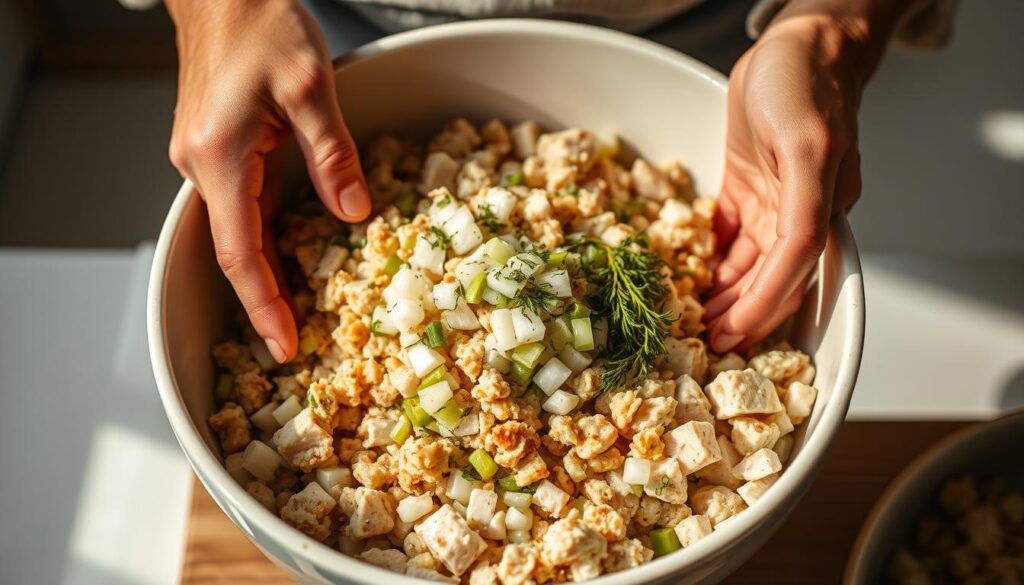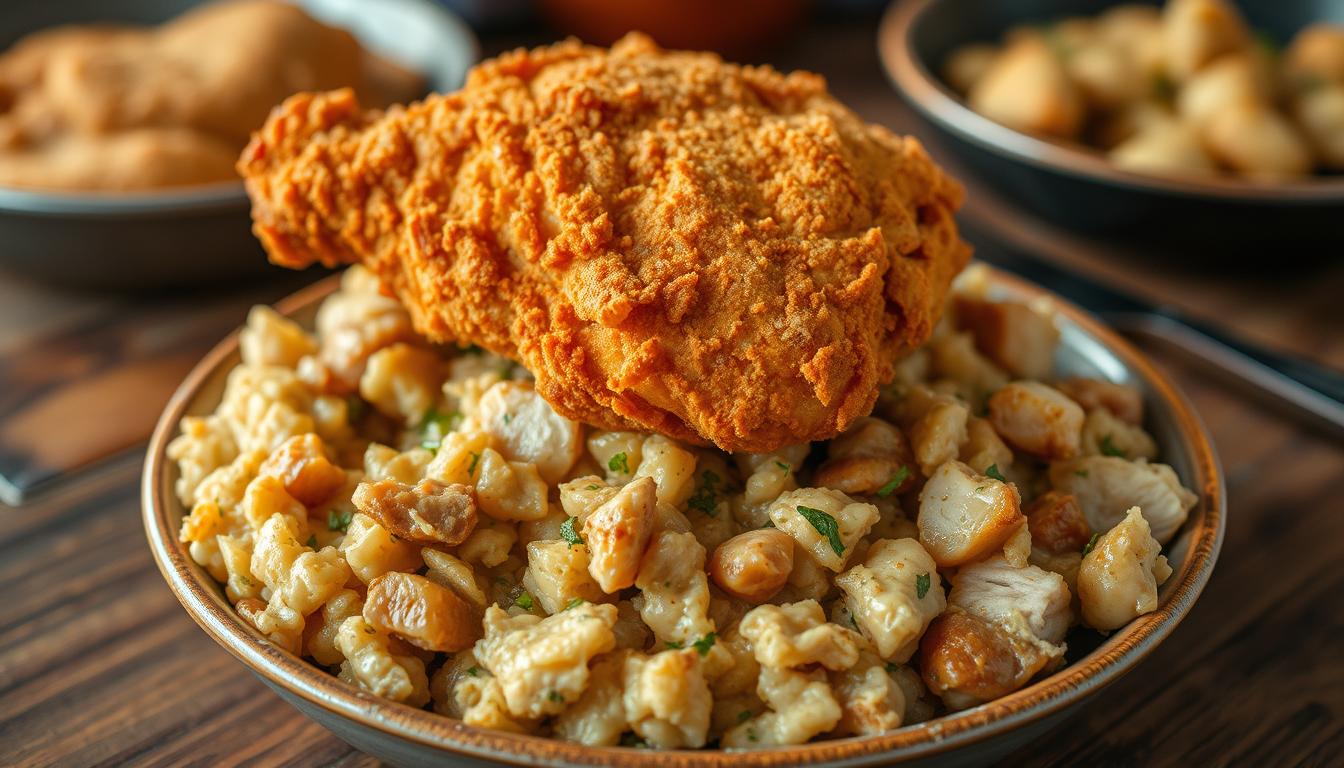Southern cuisine brings comfort to the table like no other, and chicken and dressing stands as a beloved centerpiece of family gatherings. This classic dish represents more than just a meal—it’s a culinary tradition passed down through generations, warming hearts and satisfying appetites across the United States.
When you prepare homemade dressing, you’re not just cooking. You’re creating a connection to rich cultural roots that celebrate Southern cooking traditions. Every bite of chicken and dressing tells a story of family, love, and time-honored recipes that have graced dinner tables for decades.
Discover the secrets to crafting the perfect chicken and dressing with this comprehensive guide. You’ll learn techniques that transform simple ingredients into a memorable meal. For more incredible recipes and cooking inspiration, visit luyarecipes.com and explore the world of authentic Southern cooking.
Key Takeaways
- Chicken and dressing represents a quintessential Southern comfort food
- Homemade dressing connects generations through culinary tradition
- Each recipe carries unique family heritage and flavor profiles
- Southern cooking celebrates community and shared meals
- Proper technique transforms simple ingredients into extraordinary dishes
Understanding the Southern Tradition of Chicken and Dressing
Southern cuisine carries deep roots in culinary history, with traditional dressing standing as a cherished centerpiece of family gatherings and holiday meals. The rich tapestry of flavors tells a story of cultural heritage and culinary innovation that goes far beyond a simple side dish.
Origins of Southern Dressing
Your southern dressing recipe traces back to early European settlers who brought stuffing techniques from their homeland. Adapted by Southern cooks, this dish transformed into a unique culinary tradition that reflects the region’s agricultural bounty and creative cooking methods.
“Dressing is more than food—it’s a connection to our roots and family history.” – Southern Culinary Historian
Regional Variations and Influences
Different Southern states have developed their own signature approaches to traditional dressing. Georgia might use cornbread as a base, while Louisiana could incorporate Cajun spices. Each region adds its distinctive touch, creating a delicious mosaic of culinary diversity.
Cultural Significance in American Cuisine
Chicken and dressing represent more than just a meal. They symbolize comfort, community, and generational cooking traditions. From Thanksgiving tables to Sunday family dinners, this dish continues to unite people through shared memories and flavors.
Essential Ingredients for Perfect Homemade Dressing
Creating a classic dressing recipe starts with selecting the right ingredients. The foundation of any great homemade dressing is high-quality bread, typically cornbread, which gives the dish its distinctive texture and rich flavor. You’ll want to gather fresh ingredients that bring depth and character to your culinary creation.
“The secret to an exceptional dressing lies in the quality of your ingredients.” – Southern Cooking Traditions
Your ingredient list should include crumbled cornbread, chicken broth, eggs, butter, and a blend of herbs like sage, thyme, and parsley. Diced onions and celery add wonderful aromatics that elevate the homemade dressing from good to extraordinary. Fresh herbs can transform a simple recipe into a memorable dish that captures the essence of traditional Southern cooking.
Don’t be afraid to personalize your classic dressing recipe. Some cooks add chopped pecans for crunch, while others incorporate sausage or oysters for extra richness. Your choice of bread can also make a significant difference – day-old cornbread works best, as it absorbs flavors more effectively and creates a perfect texture.
For those with dietary restrictions, gluten-free cornbread or alternative bread options can easily be substituted. The key is maintaining the balance of moisture and seasoning that makes a truly exceptional homemade dressing.
The Art of Making Perfect Cornbread Base
Creating an exceptional cornbread dressing starts with mastering the perfect cornbread foundation. Your easy dressing recipe depends on getting this crucial first step right. The key is understanding how each ingredient contributes to the ultimate texture and flavor.

Traditional Southern kitchens have long understood the magic of a well-prepared cornbread base. Cast-iron skillets play a critical role in developing a crispy exterior while maintaining a tender interior. Your cornbread should be slightly crumbly yet moist enough to blend seamlessly into your dressing.
Mastering Traditional Cornbread Techniques
Select stone-ground cornmeal for authentic flavor. Buttermilk adds tanginess and helps create a tender crumb. Preheat your skillet with a touch of oil to ensure a golden, crisp bottom that will elevate your easy dressing recipe.
Moisture and Texture Secrets
Achieving the perfect moisture in your cornbread dressing requires balancing wet and dry ingredients. Use chicken broth to keep the mixture from becoming too dry. A ratio of one cup of broth per four cups of cornbread ensures a rich, succulent texture.
Preparation Planning
“Great cornbread dressing begins with thoughtful preparation.” – Southern Cooking Traditions
Make your cornbread a day ahead to allow flavors to develop. Let it sit at room temperature, covered, to maintain moisture. This advance preparation allows your dressing to absorb seasonings more effectively.
For more inspiring cornbread recipes and tips, check out our Pinterest account
Preparing Your Chicken for the Ultimate Flavor
Selecting the right chicken is crucial for creating a delicious chicken and dressing dish. Your choice of chicken can dramatically impact the overall flavor and texture of the final meal. Roasted, boiled, or rotisserie chicken all work well for baked chicken and dressing.
Start by choosing high-quality chicken. Bone-in, skin-on chicken breasts or whole chickens provide the most robust flavor. Season your chicken generously with salt, pepper, and herbs like thyme or rosemary before cooking. The goal is to create a deeply flavorful base for your chicken and dressing.
“The secret to great chicken and dressing is in the preparation of the chicken itself.” – Southern Cooking Traditions
Shredding or cubing the chicken allows it to integrate seamlessly with the dressing. After cooking, let the chicken cool slightly before breaking it into bite-sized pieces. Save the cooking liquid – this chicken broth will add moisture and depth to your baked chicken and dressing.
Pro tip: If you’re short on time, rotisserie chicken from the grocery store works perfectly. Simply remove the skin, shred the meat, and mix it into your dressing. This shortcut doesn’t compromise flavor but saves valuable preparation time.
Remember that the chicken should complement the dressing, not overpower it. Aim for a balanced blend of seasoned chicken and traditional Southern-style dressing that will have your family asking for seconds.
Step-by-Step Guide to Classic Chicken and Dressing
Creating the perfect classic dressing recipe requires careful technique and attention to detail. Your homemade chicken and dressing will become a family favorite when you master these essential cooking steps.
Mixing and Seasoning Techniques
Start by crumbling your cornbread into a large mixing bowl. An easy dressing recipe demands precise seasoning. Combine chopped herbs like sage, thyme, and parsley to create a rich flavor profile. Gradually add chicken broth to achieve the right moisture level – you want a consistency similar to thick oatmeal.
“The secret to great Southern dressing is balance and patience.” – Southern Cooking Tradition
Layering Methods for Best Results
Layering is crucial in your classic dressing recipe. Begin with a base of seasoned cornbread mixture, then add shredded chicken evenly across the dish. Ensure each layer is distributed uniformly to guarantee consistent flavor in every bite.
Baking Temperature and Timing
Preheat your oven to 350°F for an easy dressing recipe that yields perfect results. Bake uncovered for 45-50 minutes until the top turns golden brown and crispy. The center should be moist but not wet, with edges slightly crunchy.
Your chicken and dressing will be a delicious centerpiece that celebrates traditional Southern cooking techniques.
Troubleshooting Common Dressing Mistakes

Crafting the perfect homemade dressing can be tricky. Every home cook encounters challenges when preparing chicken stuffing, but don’t worry. Understanding common mistakes helps you create a delicious dish every time.
Dry dressing is a frequent problem home cooks face. To prevent this, always add enough chicken broth to your homemade dressing mixture. The key is maintaining moisture without making the stuffing soggy. Start by adding broth gradually, mixing until you reach a moist but not wet consistency.
“The secret to great chicken stuffing is balance – not too dry, not too wet.”
Uneven cooking can ruin your chicken and dressing. Ensure you spread the mixture evenly in your baking dish. Use a spatula to create a uniform layer that cooks consistently. Preheating your oven and using the right baking temperature helps achieve that perfect golden-brown top.
Lack of flavor is another common issue. Boost your homemade dressing by using fresh herbs, quality chicken stock, and seasoning generously. Don’t be afraid to experiment with sage, thyme, or rosemary to enhance the taste of your chicken stuffing.
Lastly, always let your dressing rest for 10-15 minutes after baking. This allows the flavors to settle and helps the texture become more cohesive. With these tips, you’ll transform potential cooking mishaps into a delightful culinary success.
Serving Suggestions and Complementary Side Dishes
Your Thanksgiving dressing deserves the perfect accompaniment. Elevating your traditional dressing from good to extraordinary requires thoughtful pairings and creative presentation. Whether you’re hosting a family gathering or preparing a cozy meal, knowing how to serve and store your chicken and dressing can make all the difference.
Classic Thanksgiving Pairings
Classic side dishes transform your traditional dressing into a memorable feast. Cranberry sauce brings a tart brightness that cuts through the rich flavors. Roasted Brussels sprouts add a crisp texture, while sweet potato casserole complements the savory notes of your dressing. Green bean casserole rounds out the plate with its creamy, crunchy profile.
Modern Serving Innovations
Reimagine your Thanksgiving dressing with contemporary serving techniques. Consider individual ramekins for elegant plating or create a deconstructed version that highlights each ingredient. A garnish of fresh herbs or a drizzle of herb-infused olive oil can elevate the presentation and add unexpected flavor dimensions.
Storing Your Delicious Leftovers
Proper storage ensures your traditional dressing remains delicious for days. Refrigerate in an airtight container within two hours of cooking. Most chicken and dressing will keep well for 3-4 days when stored at 40°F or below. Reheat thoroughly to an internal temperature of 165°F to maintain food safety and flavor.
For more inspiring serving suggestions and side dish recipes, visit luyarecipes.com and discover new ways to make your meal extraordinary!
Variations on Traditional Chicken and Dressing
Your classic southern dressing recipe doesn’t have to be limited to one traditional approach. Creative cooks can transform baked chicken and dressing into exciting culinary experiences that suit different tastes and dietary needs.
Seafood lovers might explore oyster dressing, a coastal variation that adds briny richness to the classic recipe. Meat enthusiasts can experiment with sausage dressing, which introduces a spicy kick to the traditional preparation. These variations maintain the core essence of southern comfort food while offering unique flavor profiles.
“Cooking is about personal expression – don’t be afraid to make the recipe your own!” – Southern Kitchen Magazine
For those with dietary restrictions, vegetarian and gluten-free adaptations are entirely possible. Replace chicken with mushrooms or plant-based proteins, and use gluten-free cornbread as your base. Each modification brings new life to the beloved southern dressing recipe.
Seasonal variations can also elevate your baked chicken and dressing. Consider adding sage during autumn, cranberries for winter celebrations, or fresh herbs in spring. Check out visual inspiration and more recipe ideas at Pinterest/luyarecipes for endless culinary creativity.
Conclusion
Creating traditional dressing is more than just preparing a meal—it’s about preserving a culinary heritage that connects generations. Your journey through this chicken and dressing guide equips you with the skills to transform simple ingredients into a memorable dish that reflects the warmth of Southern cooking.
Every recipe tells a story, and your homemade chicken and dressing will become a cherished narrative in your family’s cookbook. By mastering the techniques shared in this guide, you’ll craft a dish that speaks to tradition, comfort, and the art of home cooking. Remember that practice makes perfect, and each time you prepare this classic recipe, your skills will improve.
For more inspiring recipes and cooking tips that celebrate regional American cuisine, visit luyarecipes.com. Our culinary experts are dedicated to helping home cooks like you explore delicious traditions and create meals that bring people together. Whether you’re a seasoned cook or a curious beginner, your kitchen is the perfect place to keep these timeless recipes alive.
Embrace the joy of cooking, share your culinary creations, and continue exploring the rich tapestry of traditional dressing and Southern comfort food. Your next delicious meal is just a recipe away!
FAQ
What makes Southern chicken and dressing different from traditional stuffing?
Southern chicken and dressing is typically made with crumbled cornbread as a base, whereas traditional stuffing often uses white bread. It’s usually prepared separately from the bird and has a more custard-like texture, with the addition of chicken broth and eggs to create a moist, rich dish that’s baked in a separate pan.
Can I make chicken and dressing ahead of time?
Absolutely! You can prepare the cornbread base and mix most ingredients a day in advance. Simply cover and refrigerate the prepared dressing, then bake it just before serving. Unbaked dressing can be stored in the refrigerator for up to 24 hours, which can actually help the flavors meld together even more deliciously.
How do I prevent my dressing from becoming too dry?
The key to avoiding dry dressing is to add enough chicken broth and eggs to create a moist mixture. Start by adding broth gradually, mixing until the consistency is similar to a thick bread pudding. Cover the dish with foil while baking for the first part of the cooking time, and consider adding an extra splash of broth if the mixture seems too dry.
Is it possible to make a gluten-free version of chicken and dressing?
Yes, you can easily create a gluten-free chicken and dressing by using gluten-free cornbread or breadcrumbs. Replace traditional flour with gluten-free alternatives like almond flour or cornstarch, and ensure all your seasonings and broth are certified gluten-free.
How long can I store leftover chicken and dressing?
Properly stored in an airtight container, chicken and dressing will keep in the refrigerator for 3-4 days. Always reheat thoroughly to an internal temperature of 165°F to ensure food safety. For best quality, consume within the first two days and reheat only once.
Can I freeze chicken and dressing?
Chicken and dressing freezes exceptionally well. Allow the dish to cool completely, then store in an airtight container or freezer-safe bag for up to 3 months. When you’re ready to enjoy it, thaw in the refrigerator overnight and reheat in the oven to maintain its original texture.
What are the best herbs to use in chicken and dressing?
Traditional Southern recipes often include sage, thyme, and parsley. Sage provides a classic holiday flavor, thyme adds depth, and parsley brings a fresh, bright note. Fresh herbs typically provide more intense flavor than dried, but dried herbs work well too if that’s what you have on hand.
How can I make my chicken and dressing more flavorful?
Enhance the flavor by using homemade chicken stock instead of store-bought, adding sautéed onions and celery, incorporating fresh herbs, and seasoning generously with salt and pepper. Some cooks also add a splash of poultry seasoning or a bit of dried sage to intensify the traditional Southern flavor profile.









